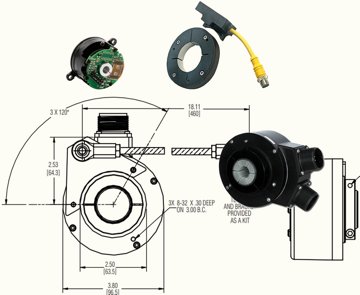When choosing the PPR value of the encoder, please keep a few simple rules in mind. Make sure that you do not choose a PPR that will cause you to exceed the maximum frequency of your controller or encoder. Try to choose a PPR that is close to the value you wish to display, this eliminates or reduces the need for a calibration constant. For example, If you wish to display 12 inches for every revolution choose a PPR of 12. If you wish to display 12.00 inches, choose 1200 PPR. However, do not make the mistake of forgetting the multiplication of the controller's input. Most controllers have X2 or X4 logic. If it is X2 logic, this would change your PPR to 600 for a 12.00 display; and the PPR would be 300 for X4 logic. These choices give you one pulse for every one unit of measurement desired. It is important to remember the frequency that your PPR will create. When choosing the PPR, do not choose one that will result in a higher frequency than the encoder can handle at your max. speed. The reverse is also true, do not choose too low of a PPR, that your controller cannot recognize the signal. Try to choose your PPR so that your calibration constant is between .5 and 1.
How do I set my Calibration Constant?
The calibration constant can be simplified by simply selecting the correct Pulses Per Revolution (PPR). Once the PPR has been selected or is known simply follow the formula presented in the Technical Manual. When choosing your calibration constant remember the closer to 1 the better. The value of the calibration constant is your best resolution per pulse of the encoder.
How Do I Choose the Pulses Per Revolution (PPR)?
Posted by London Rhodes on May 24, 2021 2:07:13 PM
Topics: How to Choose An Encoder, Installation
What is the Difference Between Quadrature and x4 Logic?
Posted by London Rhodes on May 24, 2021 1:42:15 PM
Quadrature output refers to the phasing of the output signals. When the output signals, signal A and B, are 90 degrees out of phase with each other, the output is said to be in quadrature. This is the only thing that the term quadrature implies. (see What is a Quadrature output?)
x4 Logic denotes how the controller will interpret the signal that it is receiving. This is done by translating each edge of the pulse detected for the A and B channel into its own pulse. This translation takes place in the controller and not at the encoder.
This means if you order a quadrature encoder with 120 pulses per revolution, the output of signal A and B will be out of phase by 90 degrees. It does not mean that for every one revolution that the encoder makes you will get 480 pulses. The multiplication of the pulses only occurs at the controller
What is the Purpose of the A not and B not Channels?
Posted by London Rhodes on May 24, 2021 12:36:57 PM
The A not and B
Topics: Encoder Signals Output, Troubleshooting
What Are Benefits and Key Features of the NexGen RT8 Encoder?
Posted by London Rhodes on May 6, 2021 2:06:48 PM
Along with the industry proven features that the original Rim Tach 8500 is known for, the NexGen RT8 offers users advanced feedback technology. The NexGen RT8 boasts sensors that provide up to 0.075” of air gap, over 50% more than competitive models and an expanded resolution up to 2400 PPR. The RT8 circuitry was redesigned to offer on-board diagnostics with LED and alarm output. Also, an optimized pulse wheel offers greater shaft holding force and ease of assembly
Topics: How to Choose An Encoder, New Products
Can I Return My Sensor/Wheel Inventory From an Obsolete Encoder?
Posted by London Rhodes on May 6, 2021 1:47:48 PM
Can Old Sensors/Wheels Be Applied to the NexGen (RT8) Encoder?
Posted by London Rhodes on May 6, 2021 1:40:42 PM
Why Can I Not Find The RIM Tach 8500 (R8) on Your Website?
Posted by London Rhodes on May 6, 2021 1:02:01 PM
What is the Difference Between Resolvers and Encoders?
Posted by London Rhodes on May 6, 2021 12:44:47 PM
What is Important for Encoders in Food and Beverage Applications?
Posted by London Rhodes on May 6, 2021 11:19:47 AM
Topics: How to Choose An Encoder
What Equipment Is Used To Troubleshoot Encoders?
Posted by London Rhodes on Apr 28, 2021 2:27:02 PM
Topics: Encoder Signals Output, Troubleshooting
